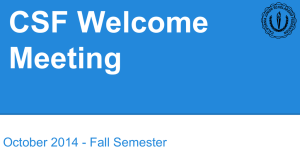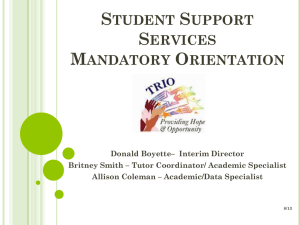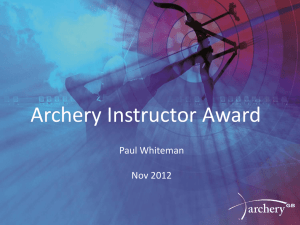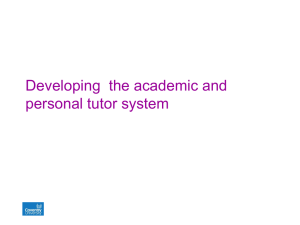: Using Peer Tutors to Improve College Students` Academic Success
advertisement
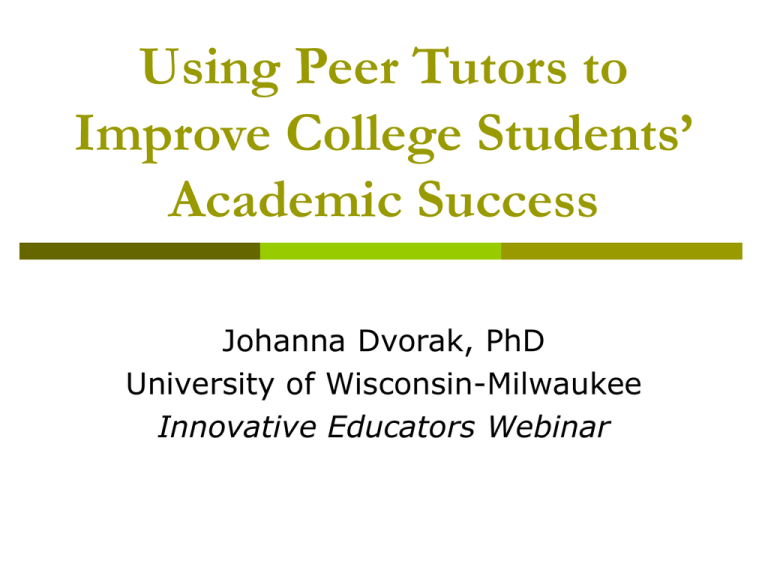
Using Peer Tutors to Improve College Students’ Academic Success Johanna Dvorak, PhD University of Wisconsin-Milwaukee Innovative Educators Webinar Introduction This webinar will assist tutoring coordinators and professionals in improving their programs and practice of tutoring at the postsecondary level. As many programs face shrinking budgets, we can maximize services and reduce costs by using student/ peer tutors. Overview This webinar will discuss three aspects of organizing a peer tutoring program to improve student learning and retention. I. Organizing peer tutoring services II. Staffing and evaluating peer tutors III. Conducting tutor training What will participants learn? Objectives Participants will be able to improve tutoring program practices in the following areas: I. Choosing the most effective peer tutoring program service components for your campus. II. Interviewing and evaluation guidelines to improve the quality of peer tutor performance III. Learn various models of tutor training and modes of delivery. Attendees Post-secondary Tutoring Program or Learning Center Managers: Colleges and Universities, Community Colleges, and Technical Colleges Post-secondary Learning Center Professionals with an interest in online tutoring New professionals in the field of college learning assistance who aspire to become program managers Speaker: Johanna Dvorak Director of Educational Support Services at University of Wisconsin-Milwaukee Tutoring Management Experience: 25+ years Leadership roles in NCLCA and NADE Frequent presenter Qualitative Researcher Organizing Peer Educator Services What types of peer educator services can you choose? Peer Tutoring Program Online Tutoring Services Supplemental Instruction Structured Learning Assistance Peer-led Study Groups Mentoring Academic Counseling What tutoring services will you offer? Types of Tutoring Individual Group Online Tutoring Walk in Scheduled weekly By appointment In Class Steps to Organizing a Tutoring Center Where and when to provide tutoring Selecting courses to be tutored Selecting tutors Promoting the program Monitor the progress of the program Evaluating the service Resources for Managing a Tutoring Program Bingham, R., Daniels, J. (1998). Developing student support groups: A tutor’s guide Brookfield, VT: Gower. Dvorak, J. “Managing tutoring aspects of the learning assistance Center,” Research for Education Reform, (9) 4, December 2004, pp. 39-51. Dvorak, J. “The college tutoring experience,” The Learning Assistance Review, (6)2, Fall 2001, pp. 33-46. Falchikov, N. (2001). Learning together: Peer tutoring in higher education. New York, NY: Routledge More Resources for Peer Educators Gottesman, B. L. (2009). Peer coaching in higher education. Lanham, MD: Rowman & Littlefield. Newton, F. B. (2000). Students helping students: A guide for peer educators on college campuses. San Francisco, CA: Jossey-Bass. Wisker, G., Exley, K., Antoniou, M., & Ridley, P. (2007). Working one-to-one with students: Supervising, coaching, mentoring, and personal tutoring. New York, NY: Routledge. Activity Planning your peer tutoring services List all the services in your center What works well? What is most attended? What changes are you seeing? What services would you like to add or develop? II. Staffing & Evaluating Peer Tutors Management Functions: Recruiting Hiring Orientation Training Evaluating Activity: Should you use peer tutors? Discuss and post on one of these: I. What are the advantages and disadvantages of using peer tutors in a college setting? or II. Problem: Brainstorm how community college programs can use peer tutors effectively when many students leave after two years. Staffing Can you use peer educators? Pros: budget savings, students are in class and know exact content, work study students, technology expertise, developing leaders Cons: continuity and expertise of staff, turnover of students which increases the need for training & supervisory staff Selecting Peer Tutors What functions will they perform? Do you need content experts? Undergraduates or graduate students? Tutoring function examples: Tutor Supplemental Instruction leader Mentor Academic Coach Program assistant to help other tutors Qualifications: Supplemental Instruction Leaders: SI leaders are model students who have usually taken the class Some are graduate students May be referred by professor or have been excellent tutors SI leaders attend course lectures & hold 34 review sessions per week SI leaders integrate course content with learning/study strategies SI Leaders vs. Tutors SI Tutor Role Role SI Tutor SI Tutor leader meets w/ faculty often determined by program training, coaching leader earns about $10 per hr. Costs for SI staff once meets faculty determined by tutor coordinator training: 10 hours per semester hour earns $9 per Cost for tutor coordinator The Interview Process Interviewing guidelines to improve the of selection peer tutors: Determining qualifications Posting the opening Screening applicants Broadening the applicant pool The interview Checking references Who make the best tutors? III. Why Tutor Training? Research Shows Better Retention: Tutor Training= higher student retention Tutor Certification Guidelines Clark-Thayer, S. & Putnam Cole, L (2ndEd). (2009). NADE self-evaluation guides: Best practices in academic support programs. Clearwater, FLA: H&H Publishing. Self- Assessment Guides: Learning Assistance (2007). Washington, DC: Council for the Advancement of Standards in Higher Education. Tutoring Certification Guidelines Tutor Program Certification CRLA Individual Tutor Certification ATP Learning Center Management Certification NCLCA Program Certification NADE Developmental Education Courses Tutoring Course-Based Learning Assistance Training Tutors Training Formats Hold training prior to the semester Pay student workers to attend meetings throughout the semester Tutor Training Course Example: The Master Tutor (Cambridge) Use a Course Management System Online Tutor Training Peer Educator Conference Cost Efficient Training Follow CRLA standards for tutor training: - 10 hours of tutoring per semester What type of training format costs less? Analyze what type of training would be most efficient: Example: Offering a tutor training course where tutors pay for credits for training rather than us paying them to get trained Activity: Tutor Training Tutor Training What formats for tutor training do you use? Which models of tutor training are or would be most effective for you? What would you like to improve or try? Develop an plan for peer tutor training for your campus. IV. Tutor Evaluation Evaluate your tutors Students evaluate tutors Staff visits tutors’ sessions Staff evaluates tutors’ overall performance Program is evaluated by Tutors Students Use Research to Evaluate Tutoring Practice Research I conducted showed that the best tutors displayed the following characteristics: Caring about students Showing sensitivity Building rapport Demonstrating flexibility Serving as role models Dvorak, J. “The college tutoring experience,” The Learning Assistance Review, (6)2, Fall 2001, pp. 33-46. Best Tutoring Practices Motivated students Set expectations Built self-confidence Developed rapport Made a connection to campus Provided mentoring (Dvorak, 2001) Top Tutoring Techniques Explained college study strategies Aided in reading college textbooks Encouraged active learning Used excellent communication skills Used visual aids and examples Adapted tutoring techniques Incorporated teaching and coaching styles (Dvorak, 2001) Benefits to Tutors Empathized with struggling students Gained the satisfaction of helping other students succeed Solidified their own knowledge Developed leadership skills Improved communication skills Increased multicultural awareness Became more prepared for future careers (Dvorak, 2001) Activity: Choose one IV. How would you evaluate your tutors? or What peer opportunities are on your campus for student leadership? How could your program collaborate to provide cross training for peer leaders? Develop a collaboration plan. Contact Information Dr. Johanna Dvorak, Director Panther Academic Support Services PASS/Bolton 180 University of Wisconsin-Milwaukee P.O.Box 413 Milwaukee, WI 53201 jdvorak@uwm.edu 414-229-5672

